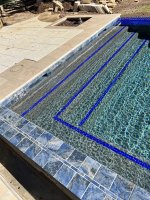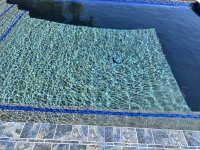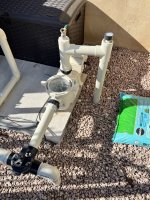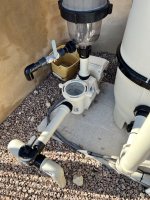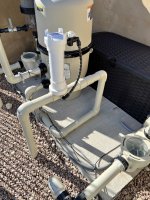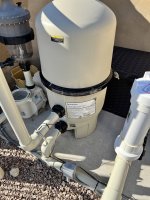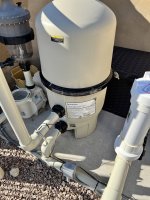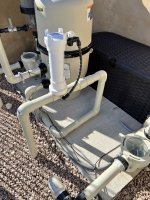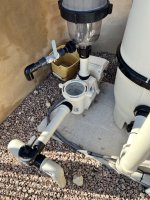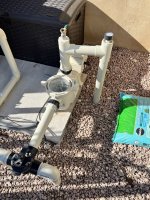Here are pics you had asked.Depends. Do you have main drains or just skimmers? Do you have a spa with the pool, or just a pool? Do you have water features?
Pics of pool and pool area and the equipment pad would also help...
Waiting for the freezing weather
- Thread starter WBW
- Start date
You are using an out of date browser. It may not display this or other websites correctly.
You should upgrade or use an alternative browser.
You should upgrade or use an alternative browser.
Thank you for the advice and will add the insulation.Even with the Feb '21 freeze, the pool water didn't freeze, at least not in my case, but the equipment pad was a concern. Fortunately for us, the "forced" blackouts that year were short-lived and I had my pipes wrapped with insulation and covered with a pipe. If you wrap the pipes and even the filter body you're a step ahead. Maybe have a couple pieces of cut up pool noodles ready to stuff in the skimmer just in case. Be ready to drain the expensive stuff (pumps and filter) if needed, but hopefully you won't have to. We had a discussion about this situation in the video below. Enjoy the new pool.
Our climate is similar to yours in that we rarely get freezes worth winterizing equipment for, but they've happened, so we plan on those emergency scenarios. We also have clients with pools such as yours, with equipment below the pool water elevation. We have methods for simplifying those emergencies, but also for our own sanity during service and repair. Our method is to shrink the amount of vulnerable material with water in it, since we can't completely drain it all.
Our local pool building habits usually place a 2-way diverter on every intake source (skimmer/main/cleaner etc) so those can be utilized as a stop valve to block gravity-borne pool water rushing into the equipment from the suction side, but in the case a set up like yours where your 3-way creates an "either/or" between the skimmer and main, the easiest thing to do is simply add another 2-way valve after the 3-way. It would be used rarely, but will serve as that dam when you need it.
On the return line/s of elevated pools, you can use a check-valve instead of a diverter valve. Or you can use another diverter. The benefit of a check-valve is it's more or less 'automatic'.
These two considerations work in unison and allow us to pull equipment out entirely when we do repairs to pumps, heaters, salt cells and diverters and avoid the hassle of the pool draining all over us when that pool water is above grade.
In rare winters freezes, we can quickly close those diverters and drain all the equipment. All that's left is to then insulate or heat-tape wrap the small amount of remaining plumbing near the ground. I'd wager running 10ft of heat-tape on these small sections with your generator would be less nerve-wracking that running a pool pump attached to everything else including your centrifugal pre-filter (hard to wrap).
Or at least, it makes us feel better on cold winters nights!
Our local pool building habits usually place a 2-way diverter on every intake source (skimmer/main/cleaner etc) so those can be utilized as a stop valve to block gravity-borne pool water rushing into the equipment from the suction side, but in the case a set up like yours where your 3-way creates an "either/or" between the skimmer and main, the easiest thing to do is simply add another 2-way valve after the 3-way. It would be used rarely, but will serve as that dam when you need it.
On the return line/s of elevated pools, you can use a check-valve instead of a diverter valve. Or you can use another diverter. The benefit of a check-valve is it's more or less 'automatic'.
These two considerations work in unison and allow us to pull equipment out entirely when we do repairs to pumps, heaters, salt cells and diverters and avoid the hassle of the pool draining all over us when that pool water is above grade.
In rare winters freezes, we can quickly close those diverters and drain all the equipment. All that's left is to then insulate or heat-tape wrap the small amount of remaining plumbing near the ground. I'd wager running 10ft of heat-tape on these small sections with your generator would be less nerve-wracking that running a pool pump attached to everything else including your centrifugal pre-filter (hard to wrap).
Or at least, it makes us feel better on cold winters nights!
- Jul 17, 2019
- 3,731
- Pool Size
- 13000
- Surface
- Plaster
- Chlorine
- Salt Water Generator
- SWG Type
- Pentair Intellichlor IC-40
Your winters are pretty mild. You may get a handful of days a year where your night time temps drop below 32. According to google, San Antonio averages 1 day every 5 years where daytime temps stay below freezing for a full day.
Even in that 1 day, you will be fine as long as your equipment is running.
Our winters are a bit more harsh in the Dallas area, and here is my plan of action:
1. Rely on the equipment freeze protection to keep pipes from freezing
2. Have a backup plan in case you have equipment failure or a power outage during a prolonged hard freeze. In your case, this should suffice in any "oh crud" situations where #1 will not suffice:
Even in that 1 day, you will be fine as long as your equipment is running.
Our winters are a bit more harsh in the Dallas area, and here is my plan of action:
1. Rely on the equipment freeze protection to keep pipes from freezing
2. Have a backup plan in case you have equipment failure or a power outage during a prolonged hard freeze. In your case, this should suffice in any "oh crud" situations where #1 will not suffice:
- Flip the breaker on your power
- Use rubber plugs in the returns
- Drain the equipment using the plugs at the bottom of your pump/filter/heater etc.
- Cover the equipment with a tarp and wait for warmer temps
mfifield01
Well-known member
My PB mentioned using heat tape in the winter. Does anyone use heat tape as a backup? My thought is that you could keep the pipes warm during a power outage. I have a 120V RV generator in my garage, that would easily power the heat tape.
My current plan would be a tarp and drop light, but I would probably have to drain if the power went out.
My current plan would be a tarp and drop light, but I would probably have to drain if the power went out.
- Jul 17, 2019
- 3,731
- Pool Size
- 13000
- Surface
- Plaster
- Chlorine
- Salt Water Generator
- SWG Type
- Pentair Intellichlor IC-40
I would not solely rely on the heat tape. Moving water will not freeze in TX, so your only concern would be if the power was out or your equipment was broken and could not run during a prolonged deep freeze. At that point, you would have to drain the water from your equipment. Sure you could add heat tape to the pipes if you think there is any standing water in them, but the draining of the water should be the priority.My PB mentioned using heat tape in the winter. Does anyone use heat tape as a backup? My thought is that you could keep the pipes warm during a power outage. I have a 120V RV generator in my garage, that would easily power the heat tape.
My current plan would be a tarp and drop light, but I would probably have to drain if the power went out.
Thanks for the suggestions and spoke with my PB. They mentioned a check -valve in several places and will have a plumber out here shortly. I've asked about the freeze issue but you brought up a great suggestion as to how to work on the equipment. One member of the team has suggested the exact recommendation you stated as it would be easier to clean the filters, etc. The more I look into the pipes with possible freezing, I'm more inclined to move toward a generator. On those freezing days, which are normally anywhere from 5-15 days every winter here in central TX, I'll place blankets and let the pumps run(I have freeze protection) which I assume will suffice. The generator will just add comfort for those days we don't have electricity for hrs/days. Again, thanks for your suggestions. Appreciate the feedback.Our climate is similar to yours in that we rarely get freezes worth winterizing equipment for, but they've happened, so we plan on those emergency scenarios. We also have clients with pools such as yours, with equipment below the pool water elevation. We have methods for simplifying those emergencies, but also for our own sanity during service and repair. Our method is to shrink the amount of vulnerable material with water in it, since we can't completely drain it all.
Our local pool building habits usually place a 2-way diverter on every intake source (skimmer/main/cleaner etc) so those can be utilized as a stop valve to block gravity-borne pool water rushing into the equipment from the suction side, but in the case a set up like yours where your 3-way creates an "either/or" between the skimmer and main, the easiest thing to do is simply add another 2-way valve after the 3-way. It would be used rarely, but will serve as that dam when you need it.
On the return line/s of elevated pools, you can use a check-valve instead of a diverter valve. Or you can use another diverter. The benefit of a check-valve is it's more or less 'automatic'.
These two considerations work in unison and allow us to pull equipment out entirely when we do repairs to pumps, heaters, salt cells and diverters and avoid the hassle of the pool draining all over us when that pool water is above grade.
In rare winters freezes, we can quickly close those diverters and drain all the equipment. All that's left is to then insulate or heat-tape wrap the small amount of remaining plumbing near the ground. I'd wager running 10ft of heat-tape on these small sections with your generator would be less nerve-wracking that running a pool pump attached to everything else including your centrifugal pre-filter (hard to wrap).
Or at least, it makes us feel better on cold winters nights!
Thanks for the comments. I fact that the pumps are not working I didn't even think about it. Having a generator wouldn't help! I have the PB coming this week to put some check-valves. The suggestions from you and others have prompted me to act fast before winter comes here in central TX. Again, thanks for the suggestions.I would not solely rely on the heat tape. Moving water will not freeze in TX, so your only concern would be if the power was out or your equipment was broken and could not run during a prolonged deep freeze. At that point, you would have to drain the water from your equipment. Sure you could add heat tape to the pipes if you think there is any standing water in them, but the draining of the water should be the priority.
You are absolutely right about the handful of days below 32. Leaving out that pitiful year the grid went down 2 years ago, I can't recall any time our electricity went out for days let alone long hrs in the past 40 years! But needing a contingency plan as you mention is something I need to do. Thanks for your remarks.Your winters are pretty mild. You may get a handful of days a year where your night time temps drop below 32. According to google, San Antonio averages 1 day every 5 years where daytime temps stay below freezing for a full day.
Even in that 1 day, you will be fine as long as your equipment is running.
Our winters are a bit more harsh in the Dallas area, and here is my plan of action:
1. Rely on the equipment freeze protection to keep pipes from freezing
2. Have a backup plan in case you have equipment failure or a power outage during a prolonged hard freeze. In your case, this should suffice in any "oh crud" situations where #1 will not suffice:
- Flip the breaker on your power
- Use rubber plugs in the returns
- Drain the equipment using the plugs at the bottom of your pump/filter/heater etc.
- Cover the equipment with a tarp and wait for warmer temps
- Jul 17, 2019
- 3,731
- Pool Size
- 13000
- Surface
- Plaster
- Chlorine
- Salt Water Generator
- SWG Type
- Pentair Intellichlor IC-40
Cool, and if it makes you feel better, all of the pools on the street behind me had power the entire time during the crazy winter 2 years ago. Even at -2 degrees and single digits for several days, their pools were just running away just fine.
My street is apparently on a less critical grid than the other 500+ homes in our hood, and our power was part of the rolling blackouts. Even only losing power for 15 mins per hour, I could not keep the ice from forming on the pool and had to throw in the towel and do my oh crud plan of draining the equipment. It took about 15 minutes to do, and I had no damage. Hopefully I never have to do that again, but I have a plan just in case.
My street is apparently on a less critical grid than the other 500+ homes in our hood, and our power was part of the rolling blackouts. Even only losing power for 15 mins per hour, I could not keep the ice from forming on the pool and had to throw in the towel and do my oh crud plan of draining the equipment. It took about 15 minutes to do, and I had no damage. Hopefully I never have to do that again, but I have a plan just in case.
Good for you for taking action! Thank God for the TX grid won't collapse again....Cool, and if it makes you feel better, all of the pools on the street behind me had power the entire time during the crazy winter 2 years ago. Even at -2 degrees and single digits for several days, their pools were just running away just fine.
My street is apparently on a less critical grid than the other 500+ homes in our hood, and our power was part of the rolling blackouts. Even only losing power for 15 mins per hour, I could not keep the ice from forming on the pool and had to throw in the towel and do my oh crud plan of draining the equipment. It took about 15 minutes to do, and I had no damage. Hopefully I never have to do that again, but I have a plan just in case.
You're welcome!Thanks for the suggestions and spoke with my PB. They mentioned a check -valve in several places and will have a plumber out here shortly. I've asked about the freeze issue but you brought up a great suggestion as to how to work on the equipment. One member of the team has suggested the exact recommendation you stated as it would be easier to clean the filters, etc. The more I look into the pipes with possible freezing, I'm more inclined to move toward a generator. On those freezing days, which are normally anywhere from 5-15 days every winter here in central TX, I'll place blankets and let the pumps run(I have freeze protection) which I assume will suffice. The generator will just add comfort for those days we don't have electricity for hrs/days. Again, thanks for your suggestions. Appreciate the feedback.
For what it's worth, the check valve will only work on the return/pressure side (after the pump). This is because a check-valve allows water to flow one way only, and the water should always exit and never come backward into a pool system regardless of elevations differences between equipment or pool water. Did they say what other places they would add one? Or was it plural simply because they'll be giving you one for each return line for each pump?
A check-valve won't work on the suction/intake side because it would of course need to be positioned so that it the flow of water is "into" the pump. Issue would then be that the gravitational force on your pool water will likely be enough to open the spring in the check-valve, even without the pump on. To stop that water, the check-valve would have to face the other direction, which would also of course completely choke your pump when it tried to run.
This is why we rely on diverters instead on the suction side. A 2-way diverter is basically a ratio dam, and will allow or restrict water from both directions simultaneously.
The only circumstance where a check-valve on the suction-side is useful is if your pool equipment is significantly above the pool water, to help the pump stay primed as seals wear out. Of course, your water vs equipment elevation is the opposite!
As far as the generator is concerned; I do still suggest adding the diverters and check-valve and using the power to run heat-tape on your pipes, instead of running your pumps. The only pipes you'd even have to worry about at that point would be the couple feet before the intake diverter and after the return check-valve.
If your equipment is able to be properly drained, you're guaranteed it can't freeze and crack volutes or filter canisters (and heaters). Then, absolute worst case, your only exposure is failure of the heat tape or generator and you MAY have a crack in the insulated pipe near the ground. Replacing broken pipe is so much less expensive than replacing equipment!
Last edited:
Honesty, I"m all new to this but they indicated one was in front of the chlorinator and the other I believe in front of the WaterCo Multi Cyclone filter. I have attached several pics of our equipment pad allowing you to see if, in fact, your suggestions fit our application. I definitely will bring up the diverters to the PB. If it helps, in order, left to right, pump pic, pool filter, chlorinator, and then inline cleaner. BTW, when building, I noticed two areas near the pool where PVC piping was visible. One pipe, against the pool wall(our backside is about 2-3ft above grade) I questioned and they covered it with cement. The other was buried with dirt. Only bring this up as I question both areas where it may freeze due to lack of insulation. Hence, I still think maybe my best defense is IF the power goes off for a long period of time, my best option is going to Plan B by hooking up a portable generator and running the pumps. As many said here online, Central TX gets very few freezing temps for days on end. And other than two years ago, rarely electric downtime. But your suggestions are important as you mentioned regarding repairs. In fact, it was not at all about freezing temps but more about repairs that the PB had advised the plumber to come out. Thanks for your suggestions and time to reply. Appreciate the response. BillYou're welcome!
For what it's worth, the check valve will only work on the return/pressure side (after the pump). This is because a check-valve allows water to flow one way only, and the water should always exit and never come backward into a pool system regardless of elevations differences between equipment or pool water. Did they say what other places they would add one? Or was it plural simply because they'll be giving you one for each return line for each pump?
A check-valve won't work on the suction/intake side because it would of course need to be positioned so that it the flow of water is "into" the pump. Issue would then be that the gravitational force on your pool water will likely be enough to open the spring in the check-valve, even without the pump on. To stop that water, the check-valve would have to face the other direction, which would also of course completely choke your pump when it tried to run.
This is why we rely on diverters instead on the suction side. A 2-way diverter is basically a ratio dam, and will allow or restrict water from both directions simultaneously.
The only circumstance where a check-valve on the suction-side is useful is if your pool equipment is significantly above the pool water, to help the pump stay primed as seals wear out. Of course, your water vs equipment elevation is the opposite!
As far as the generator is concerned; I do still suggest adding the diverters and check-valve and using the power to run heat-tape on your pipes, instead of running your pumps. The only pipes you'd even have to worry about at that point would be the couple feet before the intake diverter and after the return check-valve.
If your equipment is able to be properly drained, you're guaranteed it can't freeze and crack volutes or filter canisters (and heaters). Then, absolute worst case, your only exposure is failure of the heat tape or generator and you MAY have a crack in the insulated pipe near the ground. Replacing broken pipe is so much less expensive than replacing equipment!
Attachments
mfifield01
Well-known member
Do you have the capability to hook up the generator to the pumps? In my current setup, I don't have a way to do it. You will need some type of transfer switch and a 240v generator. I looked into the transfer switch, but my current generator is 120v.Honesty, I"m all new to this but they indicated one was in front of the chlorinator and the other I believe in front of the WaterCo Multi Cyclone filter. I have attached several pics of our equipment pad allowing you to see if, in fact, your suggestions fit our application. I definitely will bring up the diverters to the PB. If it helps, in order, left to right, pump pic, pool filter, chlorinator, and then inline cleaner. BTW, when building, I noticed two areas near the pool where PVC piping was visible. One pipe, against the pool wall(our backside is about 2-3ft above grade) I questioned and they covered it with cement. The other was buried with dirt. Only bring this up as I question both areas where it may freeze due to lack of insulation. Hence, I still think maybe my best defense is IF the power goes off for a long period of time, my best option is going to Plan B by hooking up a portable generator and running the pumps. As many said here online, Central TX gets very few freezing temps for days on end. And other than two years ago, rarely electric downtime. But your suggestions are important as you mentioned regarding repairs. In fact, it was not at all about freezing temps but more about repairs that the PB had advised the plumber to come out. Thanks for your suggestions and time to reply. Appreciate the response. Bill
I have our electrician coming out, supposedly this week, hmmm, its already Thursday, to look at our setup. We have a breaker box at the pumps and then the lines go to our main box at the house. I haven't bought a generator yet but looked at several online and waiting until our electrician can tell me options for size. One was 4500 and the other 6500. I was asking him to put a surge protector at our breaker box near the pumps, but since we have a whole house surge protector, I may squash that idea for now. We get a lot of strikes and were thinking of added protection but asking a number of folks, it may not be needed. My whole house surge protector is 12 years old but it still has a green light so I guess it still has some charges left for strikes.Do you have the capability to hook up the generator to the pumps? In my current setup, I don't have a way to do it. You will need some type of transfer switch and a 240v generator. I looked into the transfer switch, but my current generator is 120v.
BTW, I haven't spoken to our electrician yet but was reading about an interlock device instead of a transfer switch. Cost a lot less. This device allows your generator to power your home’s entire circuit breaker panel, but it also prevents running the generator while you’re getting power from your utility company once your electric service is restored. That’s important because operating a generator while you’re also getting power from your utility company could fry your electronics, and potentially shock a utility worker working near your home.Do you have the capability to hook up the generator to the pumps? In my current setup, I don't have a way to do it. You will need some type of transfer switch and a 240v generator. I looked into the transfer switch, but my current generator is 120v.
mfifield01
Well-known member
Yes, I've looked at those as well. They basically lock out the main circuit breaker physically. It has to be off to backfeed the system.BTW, I haven't spoken to our electrician yet but was reading about an interlock device instead of a transfer switch. Cost a lot less. This device allows your generator to power your home’s entire circuit breaker panel, but it also prevents running the generator while you’re getting power from your utility company once your electric service is restored. That’s important because operating a generator while you’re also getting power from your utility company could fry your electronics, and potentially shock a utility worker working near your home.
I already had a generator for my previous RV, so it happened to be 120v. If I were to buy new, I would get this one: 6250-Watt Open Frame Inverter - Champion Power Equipment The inverter style generators are quieter and produce clean power.
Here ya go. I have a 240 plug on the outside wall of my panel
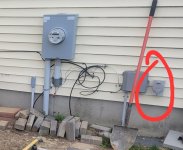
Then the panel has a 'lockout' which won't let the Generator circuit feed the house if the main breaker is on. It's a silly piece of plastic to make you consciously think about removing the home from the grid. Easy peasy and functionally safe. With basic electrical skills you could DIY for $100-$150. (I think electric supplies came back down to earth)
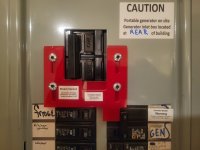

Then the panel has a 'lockout' which won't let the Generator circuit feed the house if the main breaker is on. It's a silly piece of plastic to make you consciously think about removing the home from the grid. Easy peasy and functionally safe. With basic electrical skills you could DIY for $100-$150. (I think electric supplies came back down to earth)

Yes, I've looked at those as well. They basically lock out the main circuit breaker physically. It has to be off to backfeed the system.
I already had a generator for my previous RV, so it happened to be 120v. If I were to buy new, I would get this one: 6250-Watt Open Frame Inverter - Champion Power Equipment The inverter style generators are quieter and produce clean power.
Yes, you're correct and the interlock is a lot cheaper. You do have the inconvenience of turning off all the breakers and flipping on the ones you want with the generator. I wasn't looking at the inverter-type generators as they tend to be more expensive but I like the one, you picked out. Here is one mentioned on ConsumerReports, WEN 8750-Watt Gasoline Portable Inverter Generator. Interesting as they are similar costs to dual generators. Bill
Thread Status
Hello , This thread has been inactive for over 60 days. New postings here are unlikely to be seen or responded to by other members. For better visibility, consider Starting A New Thread.


